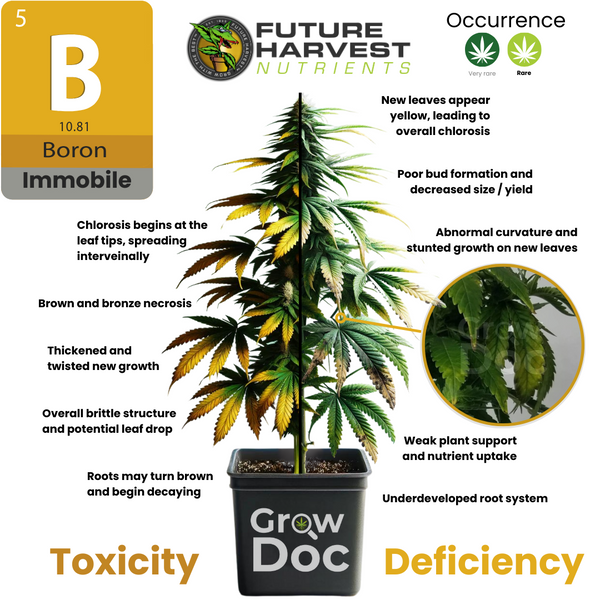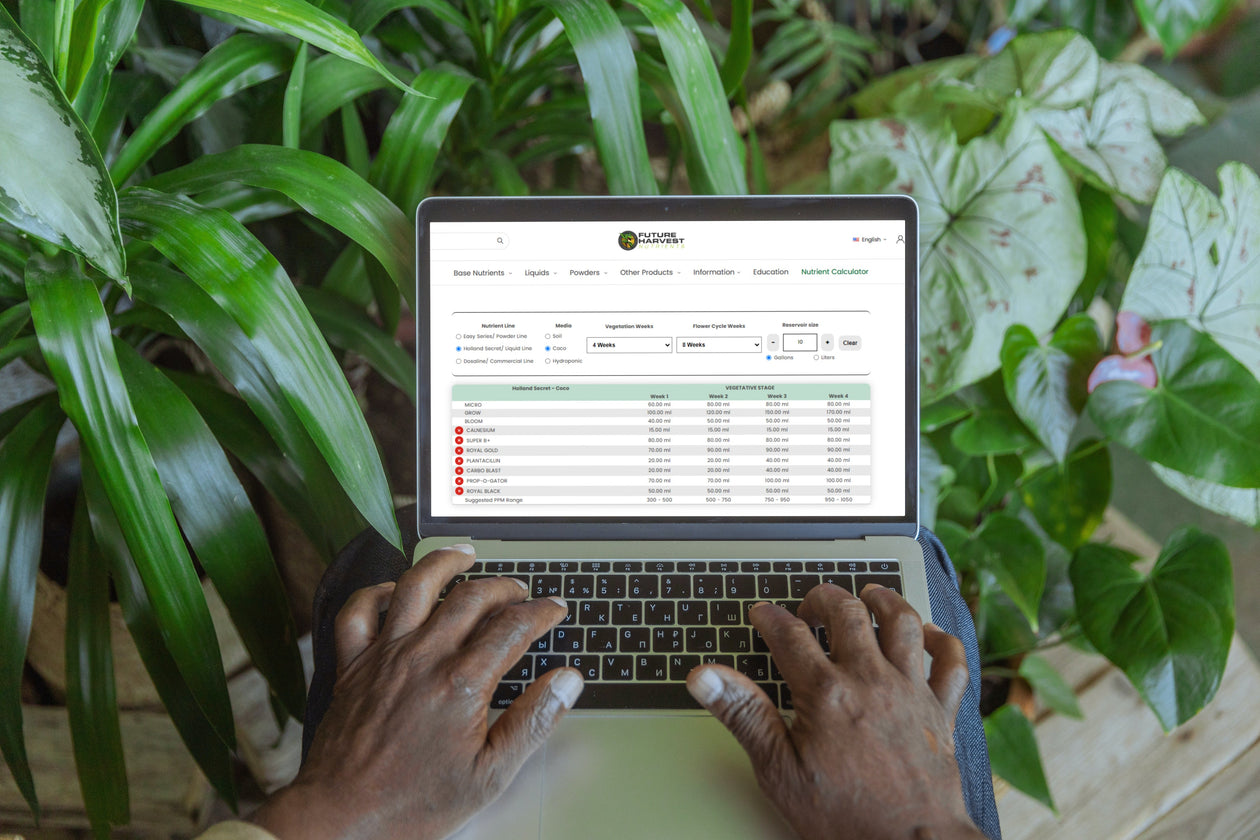How to Find and Fix Boron Deficiency in Cannabis Plants

Boron Deficiency and Toxicity in Cannabis Cultivation
Boron's balance is critical in cannabis cultivation, yet it remains one of the lesser-discussed elements in nutrient management guides. This article marks another installment in our Nutrient Management series, where we aim to provide an updated perspective to the legacy infographics widely circulated within the cannabis community, originally popularized by Jorge Cervantes.
However, achieving the perfect balance of boron can be a delicate endeavor. A recent study conducted in partnership with GrowDoc and the Horticultural & Environmental Sciences Innovation Centre at Niagara College has shed new light on the critical balance of boron in cannabis cultivation. This groundbreaking research aimed to fill a crucial gap in GrowDoc's comprehensive database, providing invaluable insights into the precise management of boron levels.
Did You Know?
Boron is crucial for cannabis plants, significantly impacting cell growth and reproductive processes. It's essential for cell wall stability and development, directly influencing plant structure and yield. Adequate boron ensures healthy growth and reproduction, underscoring its importance in nutrient management.
Discover More Boron FactsThe Role of Boron in Cannabis Plants
Boron serves as an indispensable nutrient within the cannabis lifecycle, integral to both structural integrity and physiological processes. It ensures the proper formation and strengthening of cell walls, which is essential for the overall stability and growth of the plant. By facilitating the effective transport of sugars and nutrients, boron is directly involved in energy distribution, crucial for new tissue development and the repair of damaged cells. Its role is not limited to foundational growth; boron is also imperative for the plant’s ability to combat stress, enhancing its resilience against environmental challenges.
Boron's Role in Cannabis Reproductive Health
In the reproductive phase, boron's presence is vital. It facilitates pollen germination and the growth of pollen tubes, directly affecting seed and fruit development. Adequate boron ensures successful pollination and seed production, influencing yield quality and quantity. Without sufficient boron, cannabis plants may experience reduced fertility, impacting overall production outcomes.
Expert Insight
Boron (B) is an essential micronutrient, crucial for the growth and development of crop plants. However, the essential to a toxic range of B in the plant is exceptionally narrow, and symptoms develop with a slight change in its concentration in soil. The spatial distribution of boron under its toxic condition and its accumulation in the plant might be regulated with sugar alcohols (polyols).
Common Causes for Boron Imbalances in Cannabis Cultivation
Boron imbalances in cannabis can stem from a variety of factors, each affecting the plant in different ways. Understanding these causes is essential for maintaining the health and productivity of your cannabis plants.
- Soil pH Extremes: Boron availability is highly pH-dependent. In highly acidic or alkaline soils, boron becomes less available to plants. Optimal pH levels for cannabis range from 6.0 to 7.0, where boron uptake is most efficient.
- Water Quality: Both deficiency and toxicity can be influenced by the quality of irrigation water. High boron levels in water sources can lead to toxicity, whereas low boron content might contribute to deficiency.
- Inadequate Fertilization: The absence of boron in your fertilization regime can lead to a deficiency. It’s crucial to use a balanced nutrient mix that includes micronutrients like boron.
- Overfertilization: Conversely, excessive use of boron-containing fertilizers can result in toxicity. Even small amounts above the required levels can be harmful due to boron's narrow range between deficiency and toxicity.
- Environmental Conditions: High humidity and excess rainfall can leach boron from the soil, reducing its availability. Drought conditions, on the other hand, can hinder boron uptake due to reduced water movement to the roots.
How to Find: Identifying Boron Deficiency and Toxicity
Boron Deficiency Symptoms in Cannabis Plants
Boron deficiency in cannabis manifests through a series of distinct symptoms, often affecting the plant's growth and reproductive capabilities.
-
Early Vegetative Symptoms: Initially, boron deficiency is subtle, with new growth appearing slightly stunted or twisted. Young leaves might exhibit a lighter green color than normal, and the growth of the plant can seem uneven or irregular.
-
Advanced Leaf Symptoms: As the deficiency progresses, leaves start showing more pronounced symptoms. The tips and edges may yellow or brown, a sign of chlorosis and necrosis, respectively. Leaves can become brittle, with some curling inward as if trying to conserve moisture. Veins might remain green as the leaf tissue around them yellows, creating a stark contrast.
-
Reproductive Impact: The most telling sign of boron deficiency occurs in the reproductive structures. Flowers may fail to develop correctly, appearing small or malformed. Pollen viability drops, severely affecting seed production. In severe cases, the plant may not produce viable flowers at all, leading to significantly reduced yields.
-
Root System Distress: Boron is crucial for root health. Deficient plants often have underdeveloped root systems, making them more susceptible to stress and less able to absorb water and other nutrients.
Boron Toxicity Symptoms in Cannabis Plants
While less common than deficiencies, boron toxicity can severely impact plant health and development.
-
Leaf Damage: The earliest signs of toxicity are apparent in the leaves, which may turn yellow at the margins before progressing to a burnt brown color. This damage quickly moves inward, with leaves becoming thickened and brittle, and in severe cases, entire leaves will die off.
-
Plant Stunting: Excessive boron impedes overall plant growth. New growth is particularly affected, often emerging twisted or distorted. Shoots may appear shorter than normal, with internodal spaces reduced, giving the plant a bushier appearance.
-
Root Damage: Similar to deficiency, toxicity affects the roots, but in this case, roots may appear browned or rotted due to the caustic nature of excessive boron. This damage hampers the plant's ability to uptake water and nutrients, compounding stress on the plant.
-
Reproductive Failures: Excessive boron also disrupts the normal development of reproductive organs. Buds may form but often remain small and lack the density expected. The chemical imbalance can lead to reduced terpene and cannabinoid profiles, affecting the quality and potency of the harvest.

How to Fix: Boron Deficiencies and Toxicities in Cannabis Plants
Correcting Boron Deficiency
Addressing boron deficiency requires a delicate touch due to boron's narrow safety margin between deficiency and toxicity.
-
Immediate Correction: For a quick fix, apply a foliar spray containing soluble boron. This method allows the plant to absorb boron directly through its leaves, offering rapid relief from deficiency symptoms. Be sure to follow the manufacturer's instructions to avoid overapplication.
-
Long-term Management: Incorporate a boron supplement into your nutrient regimen, choosing a product that ensures a slow, steady release of boron into the soil or growing medium. This approach is particularly effective in preventing future deficiencies. Products like borax or solubor can be mixed into the nutrient solution at very low concentrations. As with any amendment, it's critical to start with the lowest recommended dose and adjust based on plant response.
-
Soil pH Adjustment: Since boron availability is closely linked to soil pH, ensuring the pH is within the optimal range for cannabis (6.0 to 7.0) can improve boron uptake. If the soil is too acidic or alkaline, adjusting the pH can help make boron more available to your plants.
Correcting Boron Toxicity
Boron toxicity, though less common, requires prompt action to mitigate damage to the plant.
-
Immediate Action: Flush the growing medium with copious amounts of pH-balanced water. This process helps to leach excess boron from the soil or medium, reducing the concentration around the root zone.
-
Cease Boron Application: Stop any boron supplementation immediately. Review your fertilizer regimen to identify and eliminate sources of excess boron.
-
Reintroduce Nutrients: After flushing, gradually reintroduce a balanced nutrient solution without additional boron. Monitor the plant's recovery closely, adjusting your nutrient strategy to ensure balanced growth.
-
Water Management: Ensure consistent watering practices to avoid the conditions that contribute to boron buildup, particularly in soilless mediums where boron is more easily concentrated.
Accurately Monitoring Boron Levels
Regular monitoring of boron levels is essential to prevent both deficiency and toxicity, ensuring cannabis plants remain healthy throughout their growth cycle.
-
Soil and Water Testing: Begin with testing the soil and irrigation water for boron content. These tests give you a baseline understanding of the natural boron availability and help in adjusting your supplementation strategy accordingly.
-
Use of Leaf Tissue Analysis: For a more precise measure of boron levels within the plant, consider conducting a leaf tissue analysis. This method can indicate whether the plants are effectively absorbing boron from the soil, allowing for more targeted adjustments to your nutrient regimen.
-
Observational Checks: Regularly inspect your plants for signs of boron imbalance. Early detection through visual assessment can prevent minor issues from escalating into major problems affecting yield and plant health.
Maintaining Optimal Boron Levels
Maintaining optimal boron levels requires a balance of consistent monitoring, appropriate supplementation, and environmental control.
-
Balanced Fertilization: Use a comprehensive fertilizer that includes micronutrients like boron, ensuring it provides a balanced nutrient profile suited to the specific stage of plant growth. Adjust fertilization practices based on soil and tissue test results to maintain boron within the ideal range.
-
pH Management: Since boron availability is influenced by pH levels, maintaining the growing medium's pH within the optimal range for cannabis (6.0 to 7.0) is crucial. Regular pH testing and adjustments can help optimize boron uptake.
-
Environmental Control: Ensure your growing environment, whether soil, hydroponic, or coco coir, is conducive to efficient nutrient uptake. Adequate watering practices, humidity control, and temperature regulation can improve nutrient absorption, including boron.
Promoting Boron Uptake in Cannabis
Optimizing conditions for boron uptake can significantly enhance plant health and productivity. Here’s how to ensure your plants are efficiently absorbing boron:
-
Optimal Watering Practices: Boron is primarily absorbed through the roots in a dissolved form within water. Avoid over or under-watering to ensure consistent moisture levels, facilitating steady boron uptake.
-
Root Health: Healthy root systems are better able to absorb boron and other nutrients. Use practices that promote strong root development, such as using beneficial microbes or ensuring adequate aeration of the growing medium.
-
Avoiding Nutrient Lockout: Excessive levels of other nutrients, particularly calcium, can interfere with boron uptake. Ensure a balanced nutrient profile to prevent competitive inhibition, where excessive amounts of one nutrient block the absorption of another.

Optimize Your Feeding Schedule with Future Harvest
Conclusion and Next Steps
Concluding our detailed exploration of Boron Deficiency and Toxicity in Cannabis Cultivation, we've highlighted the vital importance of boron across the plant's lifecycle. Insights from the GrowDoc study have provided a foundation for understanding how to manage boron effectively to optimize plant health and productivity. From identifying signs of imbalance to implementing targeted solutions, growers are now better equipped to maintain the delicate balance of boron in their cultivation practices.
This guide aims to empower growers with the knowledge to address boron issues proactively, ensuring the well-being of their cannabis plants. By applying the strategies discussed, from soil pH adjustments to careful nutrient management, you can support your plants in achieving their full growth and reproductive potential. As part of our ongoing Nutrient Management series, we hope this article inspires continuous learning and adaptation in your cultivation journey, leading to thriving plants and successful harvests.
Explore Nutrient Deficiencies and Toxicities
| Nitrogen | Phosphorus | Potassium |
| Calcium | Magnesium | Sulfur |
| Boron | Iron | Manganese |
| Symptomology Guide | ||
